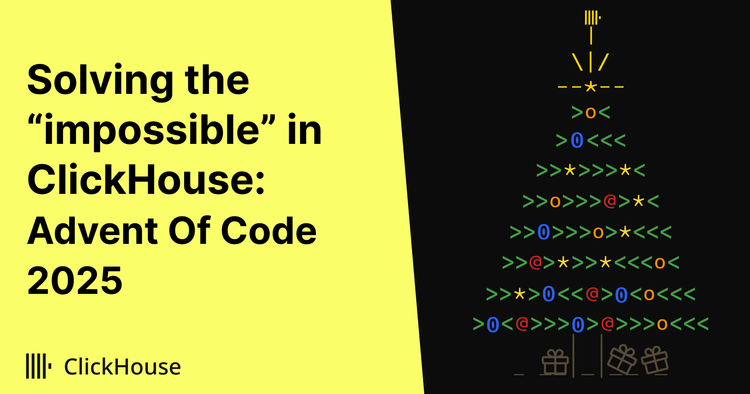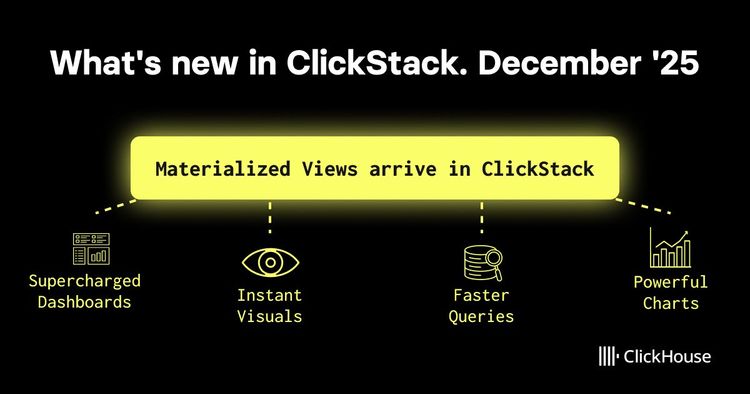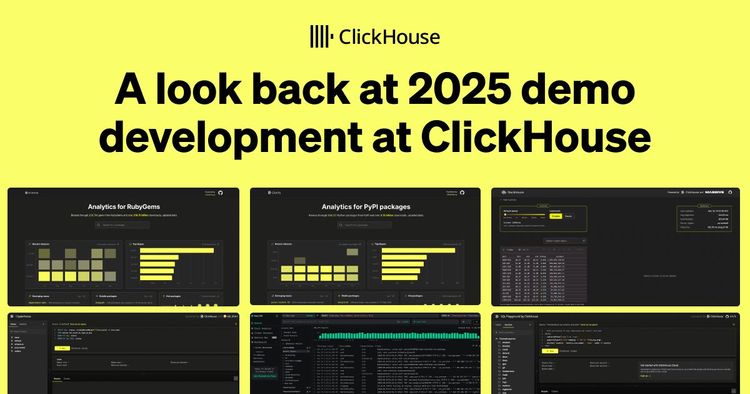It’s a holiday bonanza.
The delivery of 11 months of regular releases wasn’t enough for the team. Neither was the Early Access, Beta, and GA of ClickHouse Cloud. Speaking of which, if you want the easiest way to run ClickHouse in production (or for development) start a free trial of ClickHouse Cloud today.
As a holiday gift, we are pleased to introduce 22.12.
Release Summary #
17 new features. 8 performance optimisations. 39 bug fixes.
If that’s not enough to get you interested in trying it out. Check out some of the headline items:
grace_hashJOINs- password complexity rules
- BSON support
GROUP BY ALLsupport- Addition of a Prometheus endpoint for ClickHouse Keeper
And, of course, a host of performance improvements.
Helpful Links #
Grace Hopper Hash Join (Sergei Skvortsov + Vladimir Cherkasov) #
Historically, in ClickHouse, users had a few choices with respect to joins: either use the hash method, which is fast but memory-bound or revert to using the partial_merge algorithm. The latter relies on sorting data and dumping it to disk, often overcoming memory at the expense of performance. While this at least allowed users to execute large joins, it often suffered from slow performance. With this release, we introduce an exciting non-memory bound addition to the join algorithms, which overcomes some of the performance challenges of partial merge: The Grace Hash.
The Grace Hash algorithm utilizes a two-phased approach to joining the data. Our implementation differs slightly from the classic algorithmic description in order to fit our query pipeline.
Our first phase reads the right table and splits it into N buckets depending on the hash value of key columns (initially, N is grace_hash_join_initial_buckets). This is done in a way to ensure that each bucket can be processed independently. Rows from the first bucket are added to an in-memory hash table while the others are saved to disk. If the hash table grows beyond the memory limit (e.g., as set by max_bytes_in_join), we increase the number of buckets and recompute the assigned bucket for each row. Any rows which don’t belong to the current bucket are flushed and reassigned.
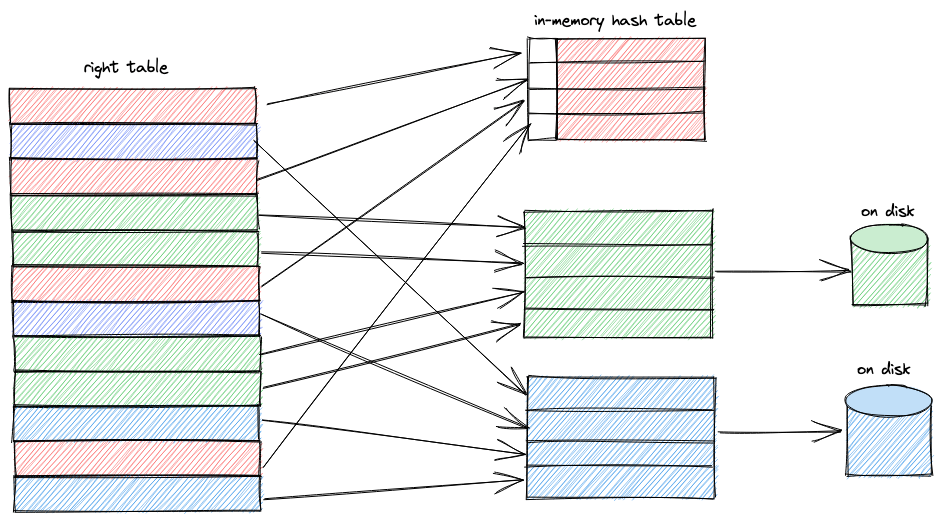
The left table is then read. Rows corresponding to the first bucket are joined (as the hash table is in memory), with others being flushed to their appropriate disk-based bucket. The key in both of these steps is that the hash function will consistently assign values to the same bucket, thereby effectively partitioning the data and solving the problem by decomposition.
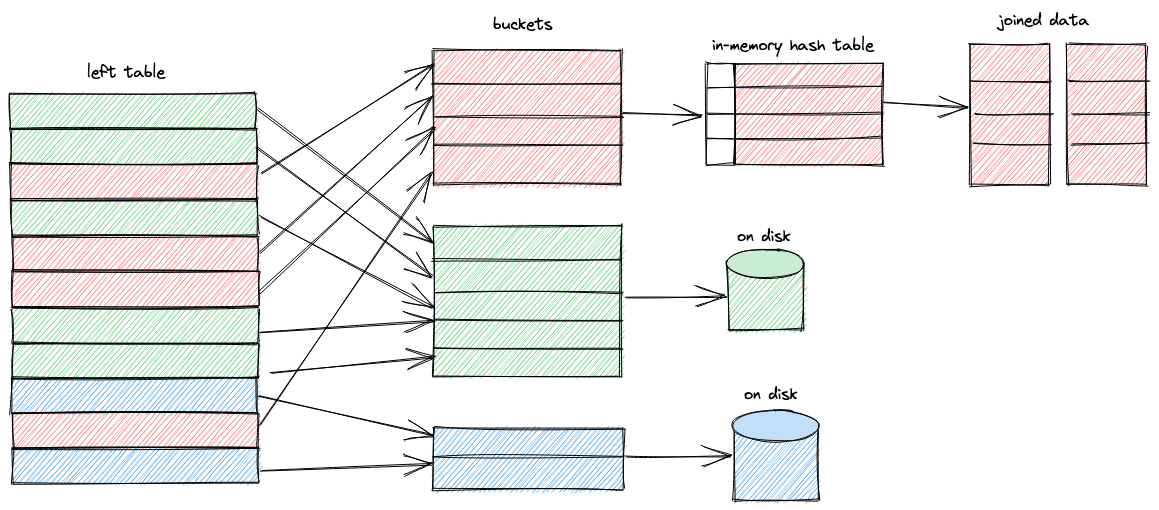
After we finish reading the left table, we must process the remaining buckets on disk. These are processed sequentially. We build the hash table for each bucket from the right table data. Again, if we run out of memory, we must increase the number of buckets. Once a hash table has been built from a right bucket, we stream the left bucket and complete the join for this pair. Note that during this step, we may get some rows that belong to another bucket other than the current due to them being saved before the number of buckets was increased. In this case, we save them to the new actual buckets and process them further. This process is repeated for all of the remaining buckets.
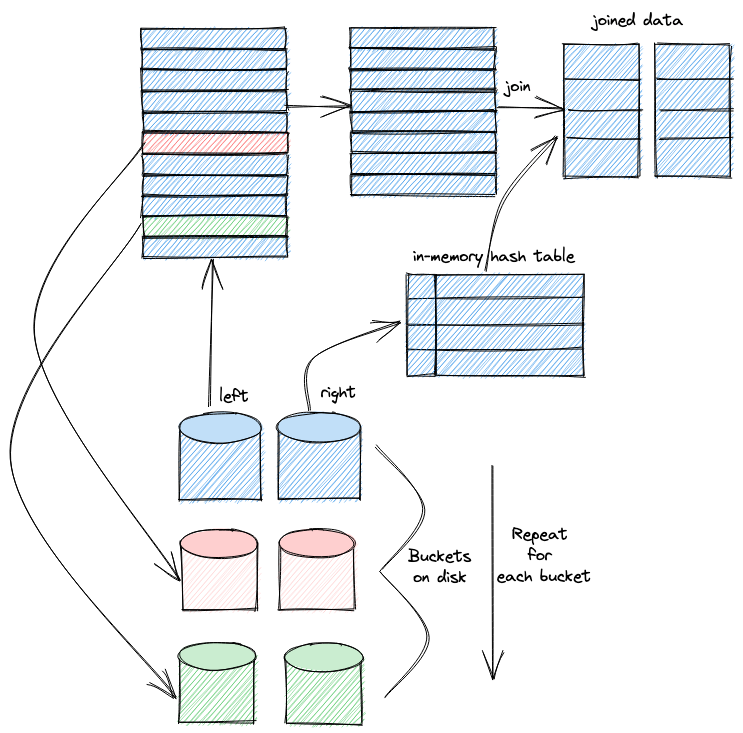
This approach of partitioning data ensures that we can both limit memory and the number of times we need to scan each table. Both sides of the table are scanned twice - once for partitioning the data and again for the join stage. While not as fast as a hash join, the performance benefits can be appreciable compared to the partial_merge.
Now let's take a practical example.
In our play.clickhouse.com, we maintain an anonymized web analytics dataset in the table hits. Every row in this table represents a website click, recording details such as the browser agent and url. The dataset also includes a Referer column (also a URL), indicating the previous location from which the visitor arrived for each URL. Suppose we identify the previous two pages visited prior to a URL, not just the immediate referer. We could solve this with a sort by time, but let's make it deliberately more tricky and solve it with graph analysis. This requires us to effectively do graph navigation of depth 2, as shown below:
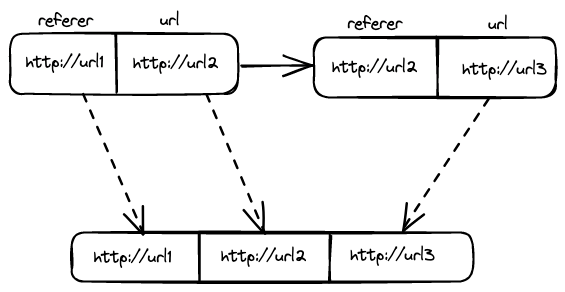
This can be realized in SQL as a self-join, where we join the hits table to itself by looking for pairs of rows that share a common URL and Referer value.
SELECT UserID, h1.Referer, h1.URL, h2.URL FROM hits AS h1 INNER JOIN hits AS h2 ON h1.UserID = h2.UserID AND h1.URL = h2.Referer WHERE h1.URL != '' AND h2.URL != '' AND h1.Referer != '' AND h2.Referer != '' ORDER BY UserID ASC LIMIT 10
While the results to this query aren’t particularly interesting, we note the performance and memory overhead for the hash, parallel_hash, partial_merge and grace_join algorithms below.

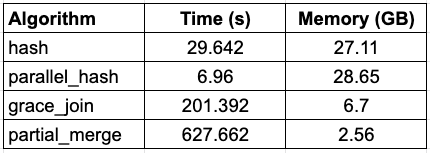
Note: the parallel_hash is a variation of a hash join that splits the data into buckets and builds several hash tables concurrently, instead of one, to speed up the join at the expense of higher memory overhead.
The results here are quite clear. Grace offers improved performance over partial_merge at the expense of more memory overhead. While hash, and more so parallel_hash, are considerably faster, you pay an overhead and rely on having sufficient memory. The choice here is up to the user. Note that these results will vary depending on your data and query.
Note the Grace Hash test here was run with the setting grace_hash_join_initial_buckets=128. The primary benefit of selecting a “correct” value for grace_hash_join_initial_buckets is it avoids the re-bucketing we described earlier - potentially speeding up the JOIN. For now, this is left to the user to tune manually.
Enforce password complexity rules (Nikolay Degterinsky) #
ClickHouse considers security to be a first-class citizen. Prior to 22.12, users could create passwords with no enforcement of complexity. While we trust our users to be responsible, mistakes and oversights happen, and weak passwords could be created. We needed to close this for our own needs with ClickHouse Cloud, but also something our community needed.
Password enforcement can be set by adding a password_complexity config key to your server configuration. An example of 4 rules enforcing a strong standard:
$ cat /etc/clickhouse-server/config.d/rules.yaml password_complexity: - rule: pattern: '.{12}' message: 'be at least 12 characters long' - rule: pattern: '\p{N}' message: contain at least 1 numeric character - rule: pattern: '\p{Lu}' message: contain at least 1 uppercase character - rule: pattern: '[^\p{L}\p{N}]' message: contain at least 1 special character
Attempts to violate this policy now result in an error e.g.,
clickhouse-cloud:) CREATE USER vasyan IDENTIFIED WITH sha256_password BY 'qwerty123' DB::Exception: Invalid password. The password should: be at least 12 characters long, contain at least 1 uppercase character, contain at least 1 special character.
We always recommend users create users and set passwords using clickhouse-client. As well as confirming the password satisfies the rules on the client side, it also ensures plain text passwords are never transmitted to the server.
BSON Support (Pavel Kruglov, Mark Polokhov) #
BSON (Binary Javascript Object Notation) is a binary-encoded Javascript Object Notation (JSON) format used for data storage and network transfer in MongoDB. Whilst based on JSON, it has a few advantages: specifically, it supports additional types such as dates and binary data as well as being faster to build and scan due to length and array indexing being encoded into the format. We expect most users to find this useful when interacting with dumps created by the mongodump tool.
The Mongo sample datasets provide some useful examples to test this feature. Assuming you’ve loaded these into your Mongo or Atlas instance, exporting and querying with ClickHouse couldn’t be simpler. Below we use clickhouse-local and query the comments from the movies dataset.
mongodump --uri="/sample_mflix" --username=default --db=sample_mflix --collection=comments --out=comments clickhouse-local SELECT count() FROM file('comments/sample_mflix/comments.bson', BSONEachRow) ┌─count()─┐ │ 41079 │ └─────────┘ 1 row in set. Elapsed: 0.236 sec. Processed 36.86 thousand rows, 21.18 MB (156.37 thousand rows/s., 89.84 MB/s.) SELECT name, text FROM file('comments/sample_mflix/comments.bson', BSONEachRow) LIMIT 1 FORMAT Vertical Query id: 7d522673-f124-4598-bdff-86b12f2905d1 Row 1: ────── name: Mercedes Tyler text: Eius veritatis vero facilis quaerat fuga temporibus. Praesentium expedita sequi repellat id. Corporis minima enim ex. Provident fugit nisi dignissimos nulla nam ipsum aliquam. 1 row in set. Elapsed: 0.048 sec.
ClickHouse Keeper - Prometheus Endpoint (Antonio Andelic) #
We have considered ClickHouse Keeper to be production ready for some time and would encourage all of our users to migrate from Zookeeper where possible. For some users, however, the ability to monitor ClickHouse Keeper in their deployments using the same approach as their legacy Zookeeper instances represented a blocker to migration. As well as improving write performance at high request rates with this release, we have therefore also added a Prometheus endpoint to ClickHouse Keeper to allow monitoring of this critical piece of software in your ClickHouse cluster. Hopefully, this unblocks some migrations and more users can benefit from more stable cluster coordination under load.
$ cat /etc/clickhouse-keeper/config.d/prometheus.yaml prometheus: port: 9369 endpoint: /metrics
GROUP BY ALL (TaoFengLiu) #
New users of ClickHouse, coming from OLTP databases such as Postgres, quickly find ClickHouse differs from ANSI SQL in a few ways. This is often deliberate as we feel these differences make analytical queries simpler and more succinct to write. In a few cases, however, we just have a few functional gaps which we’re eager to close. One of these is the ability to use the ALL clause in a GROUP BY. This simple feature means the user doesn’t need to repeat the columns from their SELECT clause, which aren’t aggregate functions, making queries even shorter and faster to write. Since we love speed, you can now utilize this feature in 22.12 thanks to a community contribution.
SELECT county, town, district, street, median(price) AS med_price, count() AS c FROM uk_price_paid WHERE toYear(date) = 2022 GROUP BY county, town, district, street ORDER BY count() DESC LIMIT 10 // and even simpler with ALL SELECT county, town, district, street, median(price) AS med_price, count() AS c FROM uk_price_paid WHERE toYear(date) = 2022 GROUP BY ALL ORDER BY count() DESC LIMIT 10

